Mesoscale Convective Systems: A Case Scenario of the ‘Heavy Rainfall’ Event of 15–20 January 2013 over Southern Africa
Abstract
1. Introduction
2. Mesoscale Convective Systems
2.1. Structure and Climatology
2.2. Convective Systems and Southern African Rainfall
3. The Heavy Rainfall of January 2013
4. Data and Methods
5. Results and Discussion
5.1. Rainfall Distribution
5.2. Temperature and Wind Pattern
5.3. Clouds and Precipitation
6. Conclusions
Author Contributions
Acknowledgments
Conflicts of Interest
References
- Hulme, M.; Doherty, R.; Ngara, T.; New, M.; Lister, D. African climate change: 1900–2100. Clim. Res. 2001, 17, 145–168. [Google Scholar] [CrossRef]
- Jury, M.R. Climate trends in southern Africa. South Afr. J. Sci. 2013, 109, 1–2. [Google Scholar] [CrossRef]
- Usman, M.; Reason, C.J.C. Dry spell frequencies and their variability over southern Africa. Clim. Res. 2004, 26, 199–211. [Google Scholar] [CrossRef]
- Bellprat, O.; Lott, F.C.; Guliza, C.; Parker, H.R.; Pampuch, L.A.; Pinto, I.; Ciavarella, A.; Stott, P.A. Unusual past dry and wet rainy seasons over Southern Africa and South America from a climate perspective. Weather and Climate Extremes. Weather Clim. Extremes 2015, 9, 36–46. [Google Scholar] [CrossRef]
- Blamey, R.C.; Reason, C.J.C. Mesoscale Convective Complexes over southern Africa. J. Clim. 2012, 25, 753–766. [Google Scholar] [CrossRef]
- World Meteorological Organization. (WMO-No. 1147). The Climate in Africa: 2013. 2015. Available online: http://www.wmo.int/pages/prog/wcp/wcdmp/documents/1147_EN.pdf. (accessed on 15 August 2018).
- Lyon, B.; Mason, S.J. The 1997–98 Summer Rainfall Season in Southern Africa. Part I: Observations. J. Clim. 2006, 20, 5134–5148. [Google Scholar] [CrossRef]
- Dyson, L.L.; van Heerden, J. A model for the identification of tropical weather systems over South Africa. Water SA 2002, 28, 249–258. [Google Scholar] [CrossRef]
- Fauchereau, N.; Trzaska, S.; Rouault, M.; Richard, Y. Rainfall Variability and Changes in Southern Africa during the 20th Century in the Global Warming Context. Nat. Hazards 2002, 29, 139–154. [Google Scholar] [CrossRef]
- Dyson, L.L.; van Heerden, J. The heavy rainfall and floods over the north-eastern interior of South Africa during February 2000. S. Afr. J. Sci. 2001, 97, 80–86. [Google Scholar]
- Triegardt, D.O.; Van Heerden, J.; Steyn, P.C.L. Anomalous Precipitation and Floods During February 1988; Technical Paper No. 23; South African Weather Service: Pretoria, South Africa, 1988. [Google Scholar]
- Shulze, R.; Meigh, J.; Horan, M. Present and potential future vulnerability of Eastern and Southern Africa hydrology and water resources. South Afr. J. Sci. 2001, 67, 150–160. [Google Scholar]
- Washington, R.; Preston, A. Extreme wet year over southern Africa: Role of Indian Ocean sea surface temperatures. J. Geophys. Res. 2006, 111, D15104. [Google Scholar] [CrossRef]
- Zipser, E.J. Use of a Conceptual Model of the Life Cycle of Mesoscale Convective Systems to Improve Very-Short-Range Forecasts. In Nowcasting (191-204); Browning, K.A., Ed.; Academic Press: New York, NY, USA, 1982; pp. 191–204. [Google Scholar]
- Buque, S.L.M. A Study of Heavy Rainfall Events During The 2006/2007 Southern Africa Summer. 2007. Available online: https://www.wmo.int/pages/prog/www/DPFS/Reports/Buque%20Case%20Study2006-2007pdf.pdf (accessed on 10 May 2019).
- Houze, R.A., Jr. Mesoscale convective systems. Rev. Geophys. 2004, 42, RG4003. [Google Scholar] [CrossRef]
- Trismidianto, Y.E.; Satyawardhana, H.; Nugroho, J.T.; Ishida, S. The Contribution of the Mesoscale Convective Complexes (MCCs) to total rainfall over Indonesian Maritime Continent. IOP Conf. Ser. Earth Environ. Sci. 2017, 54, 012027. [Google Scholar] [CrossRef]
- Houze, R.A., Jr.; Chen, S.S.; Kingsmill, D.E.; Serra, Y.; Yuter, S.E. Convection over the Pacific Warm Pool in relation to the Atmospheric Kelvin-Rossby Wave. J. Atmos. Sci. 2000, 57, 3058–3089. [Google Scholar] [CrossRef]
- Nakazawa, T. Tropical Super Clusters within Intraseasonal Variations over the Western Pacific. J. Meteorol. Soc. Jpn. 1988, 66, 823–839. [Google Scholar] [CrossRef]
- Cotton, W.R.; Bryan, G.; van den Heever, S.C. Chapter 9: Mesoscale Convective Systems. Int. Geophys. 2011, 99, 455–526. [Google Scholar]
- Yang, X.; Fei, J.; Huang, X.; Cheng, X. Characteristics of Mesoscale Convective Systems over China and Its Vicinity Using Geostationary Satellite FY2. J. Clim. 2015, 28, 4890–4907. [Google Scholar] [CrossRef]
- Feng, Z.; Leung, L.R.; Houze, R.A., Jr.; Hagos, S.; Hardin, J.; Yang, Q.; Han, B.; Fan, J. Structure and Evolution of Mesoscale Convective Systems: Sensitivity to Cloud Microphysics in Convection-Permitting Simulations Ovre the United States. J. Adv. Model. Earth Syst. 2018, 10. [Google Scholar] [CrossRef]
- Huang, X.; Hu, C.; Huang, X.; Chu, Y.; Tseng, Y.; Zhang, G.J.; Lin, Y. A long-term tropical mesoscale convective systems dataset based on a novel objective automatic algorithm. Clim. Dyn. 2018. [Google Scholar] [CrossRef]
- Conzemius, R.J.; Moore, R.W.; Montgomery, M.T.; Davis, C.A. Mesoscale Covective Vortex Formation in a Weakly Sheared Moist Neutral Environment. J. Atmos. Sci. 2016. [Google Scholar] [CrossRef]
- Laing, A.G.; Fritsch, J.M.; Negri, A.J. Contribution of Mesoscale Convective Complexes to Rainfall in Sahelian Africa: Estimates from Geostationary Infrared and Passive Microwave Data. J. Appl. Meteorol. 1999, 38, 957–964. [Google Scholar] [CrossRef]
- Laurent, H.; D’Amato, N.; Lebel, T. How important is the contribution of mesoscale convective complexes to the Sahelian rainfall. Phys. Chem. Earth 1998, 23, 629–633. [Google Scholar] [CrossRef]
- Mathon, V.; Laurent, H.; Lebel, T. Mesoscale convective system rainfall in the Sahel. J. Appl. Meteor. 2002, 41, 1081–1092. [Google Scholar] [CrossRef]
- Sall, A.M.; Sauvagoet, H.; Gaye, A.T.; Viltard, A.; Felice, P. Acyclogenesis index for tropical Atlantic off the African coast. Atmos. Res. 2005, 79, 123–147. [Google Scholar] [CrossRef]
- Rohbein, A.; Ambrizzi, T.; Mechoso, C.R. Mesoscale convective systems over the Amazon basin. Part I: climatological aspects. Int. J. Climatol. 2017, 38. [Google Scholar] [CrossRef]
- Ziegler, C.L. Issues in forecasting mesoscale convective systems: An observational and modelling perspective. In Proceedings of the Symposium on the Challenges of Severe Convective Storms, Orlando, FL, USA, 11–15 September 2000; Pielke, R.A., Jr., Pielke, R.A., Sr., Eds.; Routledge: London, UK, 2000; pp. 26–42. [Google Scholar]
- Brooks, H.E.; Lee, J.W.; Craven, J.P. The spatial distribution of severe thunderstorm and tornado environments from global reanalysis data. Atmos Res. 2003, 67–68, 73–94. [Google Scholar] [CrossRef]
- Zipser, E.J.; Cecil, D.J.; Liu, C.; Nesbitt, S.W.; Yorty, D.P. Where are the most intense thunderstorms on Earth? Bull. Am. Meteor. Soc. 2006, 87, 1057–1071. [Google Scholar] [CrossRef]
- Maddox, R.A. Mesoscale convective complexes. Bull. Am. Meteor. Soc. 1980, 61, 1374–1387. [Google Scholar] [CrossRef]
- Laing, A.G.; Fritsch, J.M. The large-scale environments of the global populations of mesoscale convective complexes. Mon. Wea. Rev. 2000, 128, 2756–2776. [Google Scholar] [CrossRef]
- Laing, A.G.; Fritsch, J.M. The global population of mesoscale convective complexes. Quart. J. Roy. Meteor. Soc. 1997, 123, 389–405. [Google Scholar] [CrossRef]
- Blamey, R.C.; Reason, C.J.C. Numerical simulation of a mesoscale convective system over the east coast of South Africa. Tellus 2009, 61A, 17–34. [Google Scholar] [CrossRef][Green Version]
- Velasco, I.; Fritsch, J.M. Mesoscale convective complexes in the Americas. J. Geophys. Res. 1987, 92, 9591–9613. [Google Scholar] [CrossRef]
- Singleton, A.T.; Reason, C.J.C. Numerical simulations of a severe rainfall event over the Eastern Cape coast of South Africa: Sensitivity to sea surface temperature and topography. Tellus 2006, 58A, 355–367. [Google Scholar]
- Singleton, A.T.; Reason, C.J.C. A numerical model study of an intense cutoff low-pressure system over South Africa. Mon. Wea. Rev. 2007, 135, 1128–1150. [Google Scholar] [CrossRef]
- Washington, R.; Todd, M.C. Tropical-temperate links in southern Africa and southwest Indian Ocean satellite-derived daily rainfall. Int. J. Climatol. 1999, 19, 1601–1616. [Google Scholar] [CrossRef]
- Manhique, A.J.; Reason, C.J.C.; Silinto, B.; Zucula, J.; Raiva, I.; Congolo, F.; Mavume, A.F. Extreme rainfall and floods in southern Africa in January 2013 and associated circulations. Nat. Hazards 2015, 77, 679–691. [Google Scholar] [CrossRef]
- Harrison, M.S.J. A generalized classification of South African rain-bearing synoptic systems. Int. J. Climatol. 1984, 4, 547–560. [Google Scholar] [CrossRef]
- Todd, M.C.; Palmer, P.I. Water vapour transport associated with tropical-temperate trough systems over southern Africa and the southwest Indian Ocean. Int. J. Climatol. 2004, 24, 555–568. [Google Scholar] [CrossRef]
- Hart, N.C.G.; Reason, C.J.C.; Faucereau, N. Tropical-extratropical interactions over southern Africa: Three cases of heavy summer season rainfall. Mon. Wea. Rev. 2010, 138, 2608–2623. [Google Scholar] [CrossRef]
- Reason, C.J.C.; Keibel, A. Tropical Cyclone Eline and its unusual penetration and impacts over the southern African mainland. Wea. Forecast. 2004, 19, 789–805. [Google Scholar] [CrossRef]
- Cook, K.H. The South Indian convergence zone and interannual rainfall variability over southern Africa. J. Clim. 2000, 13, 3789–3804. [Google Scholar] [CrossRef]
- Funk, T. Heavy Convective Rainfall Forecasting: A Comprehensive Look at Parameters, Processes, Patterns and Rules of Thumb. 2003. Available online: ttps://www.weather.gov/media/lmk/soo/heavy_rainfall_forecasting.pdf. (accessed on 10 May 2019).
- Hanlon, J. Serious floods in southern Mozambique. 2015. Available online: https://www.open.ac.uk/...ac.../Mozambique_211_floods%20-%2024Jan2013.pdf. (accessed on 10 May 2019).
- Mosase, E.; Ahiablame, L. Rainfall and Temperature in the Limpopo River Basin, Southern Africa: Means, Variations, and Trends form 1979 to 2013. Water 2018, 10, 364. [Google Scholar] [CrossRef]
- Schmid, J. The SEVIRI Instrument. In Proceedings of the 2000 EUMETSAT Meteorological Satellite. Data User’s Conference, Bologna, Italy, 29 May–2 June 2000; EUMETSAT: Darmstadt, Germany, 2000; pp. 13–32. [Google Scholar]
- Carvalho, L.M.V.; Jones, C. A satellite method to identify structural properties of mesoscale convective systems based on the maximum spatial correlation tracking technique (MASCOTTE). J. Appl. Meteor. 2001, 40, 1683–1701. [Google Scholar] [CrossRef]
- Garcia-Herrera, E.; Hernandez, D.; Paredes, D.; Barriopedro, J.F.; Correoso, L.P. A MASCOTTE-based characterization of MCSs over Spain, 2000–2002. Atmos. Res. 2015, 73, 261–282. [Google Scholar] [CrossRef]
- Laing, A.G.; Fritsch, J.M. Mesoscale convective complexes in Africa. Mon. Wea. Rev. 1993, 121, 2254–2263. [Google Scholar] [CrossRef]
- Durkee, J.D.; Mote, T.L. A climatology of warm-season mesoscale convective complexes in subtropical South America. Int. J. Climatol. 2010, 30, 418–431. [Google Scholar] [CrossRef]
- Laing, A.G.; Carbone, R.E.; Levizzani, V. Cycles and Propagation of Deep Convection over Equatorial Africa. Mon. Wea. Rev. 2011, 139, 2832–2853. [Google Scholar] [CrossRef]
- Jasinski, I.W.; Pietrek, K.K.S. Hazardous Meteorological Phenomena Forecasting Using Remote Sensing Data and Products of numerical Weather Prediction Models. In Proceedings of the International Archives of the Photogrammetry, Remote Sensing and Spatial Information Sciences, Beijing, China, 3–11 July 2008. [Google Scholar]
- Driver, P.; Reason, C.J.C. Variability in the Botswana High and its relationships with rainfall and temperature characteristics over southern Africa. Int. J. Climatol. 2017, 37 (Suppl. 1), 570–581. [Google Scholar] [CrossRef]
- Laing, A.G.; Carbone, R.E.; Levizzani, V.; Tuttle, J. The propagation and diurnal cycles of deep convection in northern tropical Africa. QJR Meteorol. Soc. 2008, 134, 93–109. [Google Scholar] [CrossRef]
- Tucker, D.F.; Crook, N.A. The generation of a mesoscale convective system from mountain convection. Mon. Wea. Rev. 1999, 127, 1259–1273. [Google Scholar] [CrossRef]
- Tucker, D.F.; Crook, N.A. Favoured Regions of Convective Initiation in the Rocky Mountains. Available online: ams.confex.com/ams/pdfpapers/22784.pdf (accessed on 15 May 2019).
- Tucker, D.F.; Crook, N.A. Flow over Heated Terrain. Part II: Generation of Convective Precipitation. Mon. Wea. Rev. 2005, 133, 2565–2582. [Google Scholar] [CrossRef][Green Version]
- Mphale, K.M.; Adedoyin, J.A.; Nkoni, G.; Ramaphane, G.; Wiston, M.; Chimidza, O. Analysis of temperature data over semi-arid Botswana: trends and break points. Meteorol. Atmos. Phys. 2017. [Google Scholar] [CrossRef]
- Poveda, G.; Waylen, P.R.; Pulwarty, R.S. Annual and inter-annual variability of the present climate in northern South America and southern Mesamerica. Paleoclimatol. Paleoclimatol. Paleoclimatol. 2006, 234, 3–27. [Google Scholar] [CrossRef]
- Mohr, K.I.; Molinari, J.; Thorncroft, C.D. The Interannual Stability of Cumulative Frequency Distributions for Convective System Size and Intensity. J. Clim. 2009, 22, 5218–5231. [Google Scholar] [CrossRef]
- Sorooshian, A.; Feingold, G.; Lebsock, M.D.; Jiang, H.; Stephens, G.L. On the precipitation susceptibility of clouds to aerosol perturbations. Geophys. Res. Lett. 2009, 36, L13803. [Google Scholar] [CrossRef]
- Diaz, J.P.; González, A.; Expósito, F.J.; Pérez, J.C.; Fernández, J.; Garcia-Díezal, M.; Taima, D. WRF-multi-physics simulation of clouds in the African region. QJR Meteorol. Soc. 2015. [Google Scholar] [CrossRef]
- Klein, S.A.; Hartman, D.L. The Seasonal Cycle of Low Stratiform Clouds. J. Clim. 1993, 6, 1587–1606. [Google Scholar] [CrossRef]
- Nicholson, S.E. A Review of Climate Dynamics and Climate Variability in Eastern Africa. In The Limnology, Climatology and Paleoclimatology of the East African Lakes; Johnson, T.C., Odada, E.O., Eds.; Gordon and Breach: Amsterdam, The Netherlands, 1996; pp. 25–56. [Google Scholar]
- Dyson, L.L. A heavy rainfall sounding climatology over Gauteng, South Africa, using self-organizing maps. Clim. Dynamics 2015, 45, 3051–3065. [Google Scholar] [CrossRef]
- Schefub, E.; Schouten, S.; Schneider, R. Climatic controls on central African hydrology during the past 200, 000 years. Nat. Publ. Group 2005, 437. [Google Scholar] [CrossRef]
- Mapes, B.E.; Warner, T.T.; Xu, M. Diurnal patterns of rainfall in northwestern South America. Part III: Diurnal gravity waves and nocturnal convection offshore. Mon. Wea. Rev. 2003, 131, 830–844. [Google Scholar] [CrossRef]
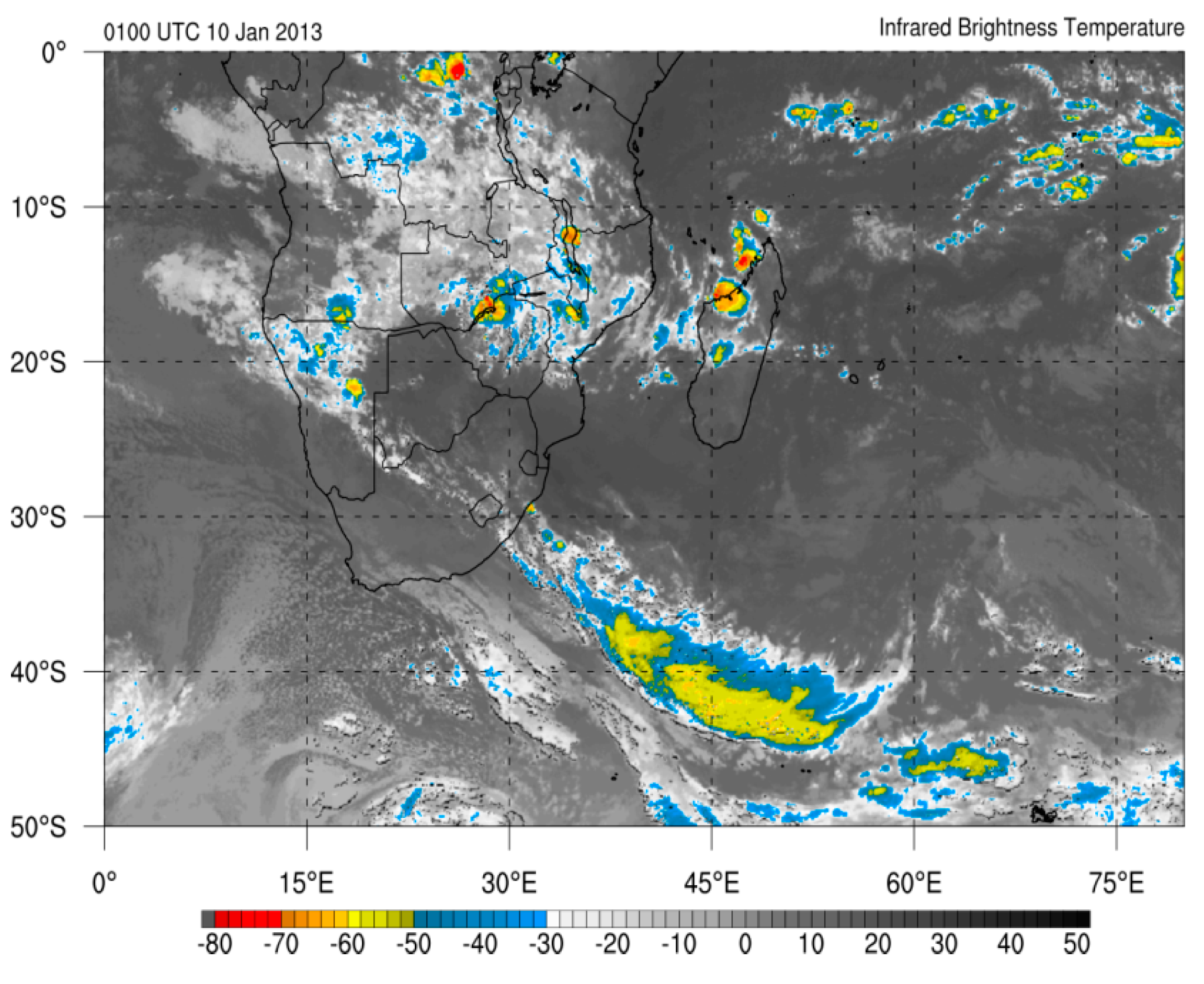
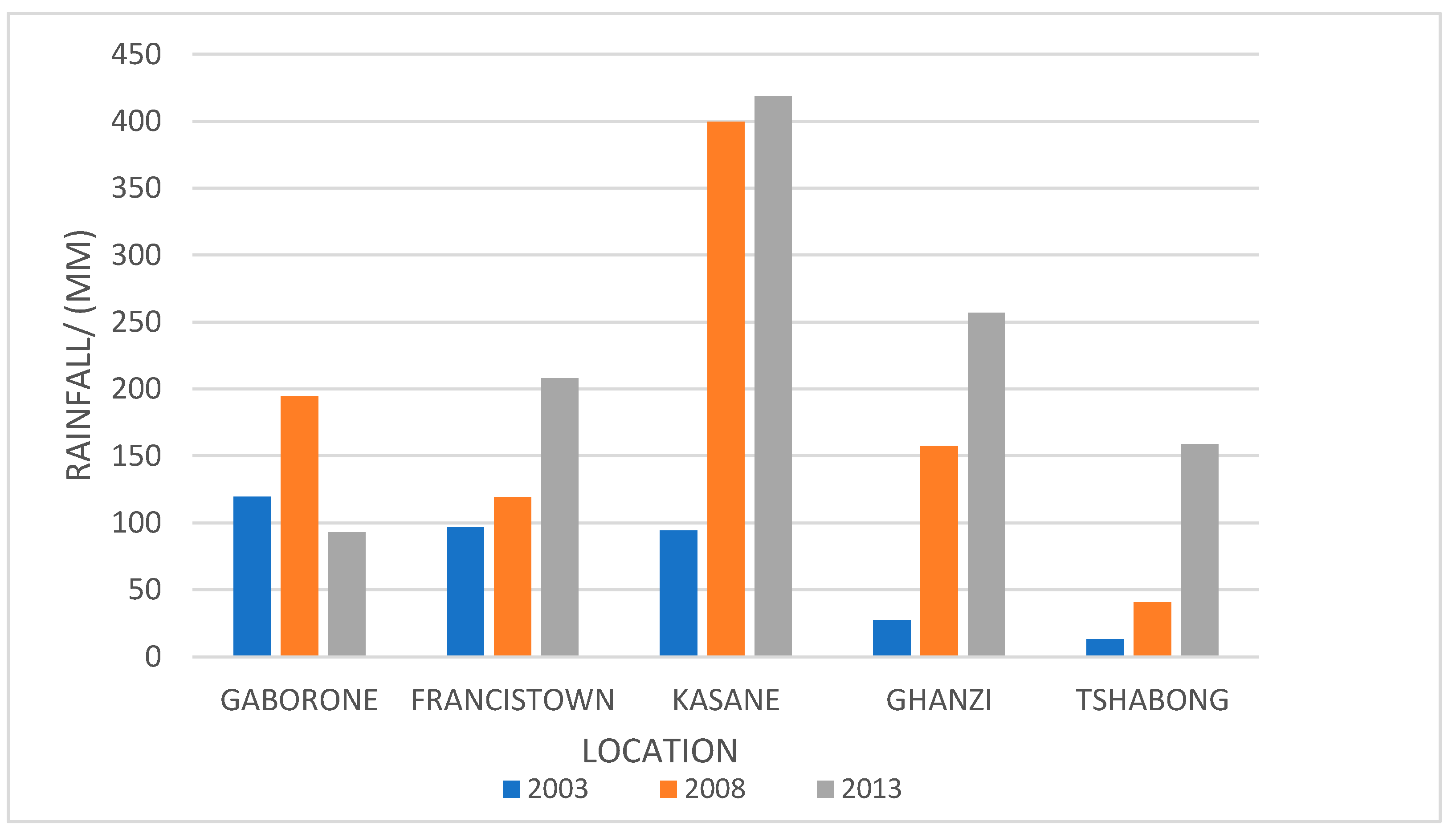
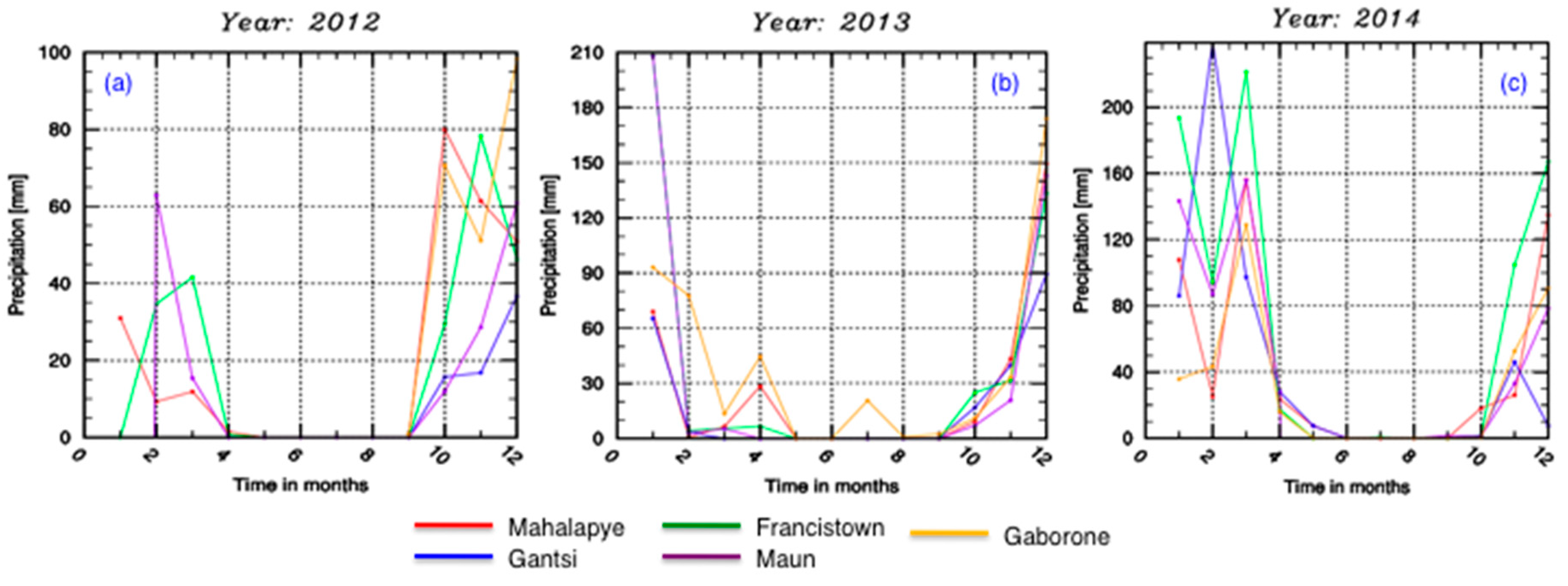
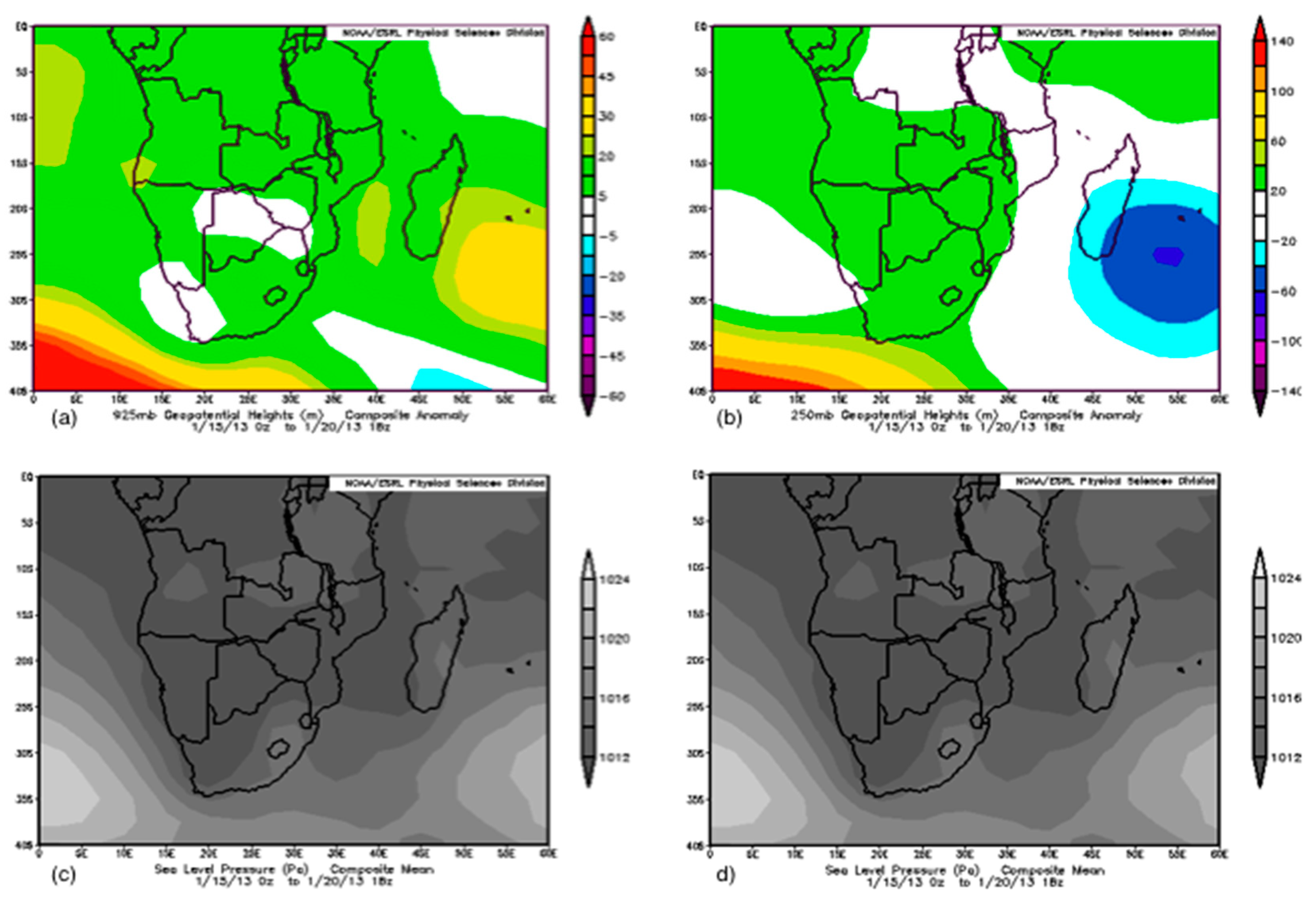
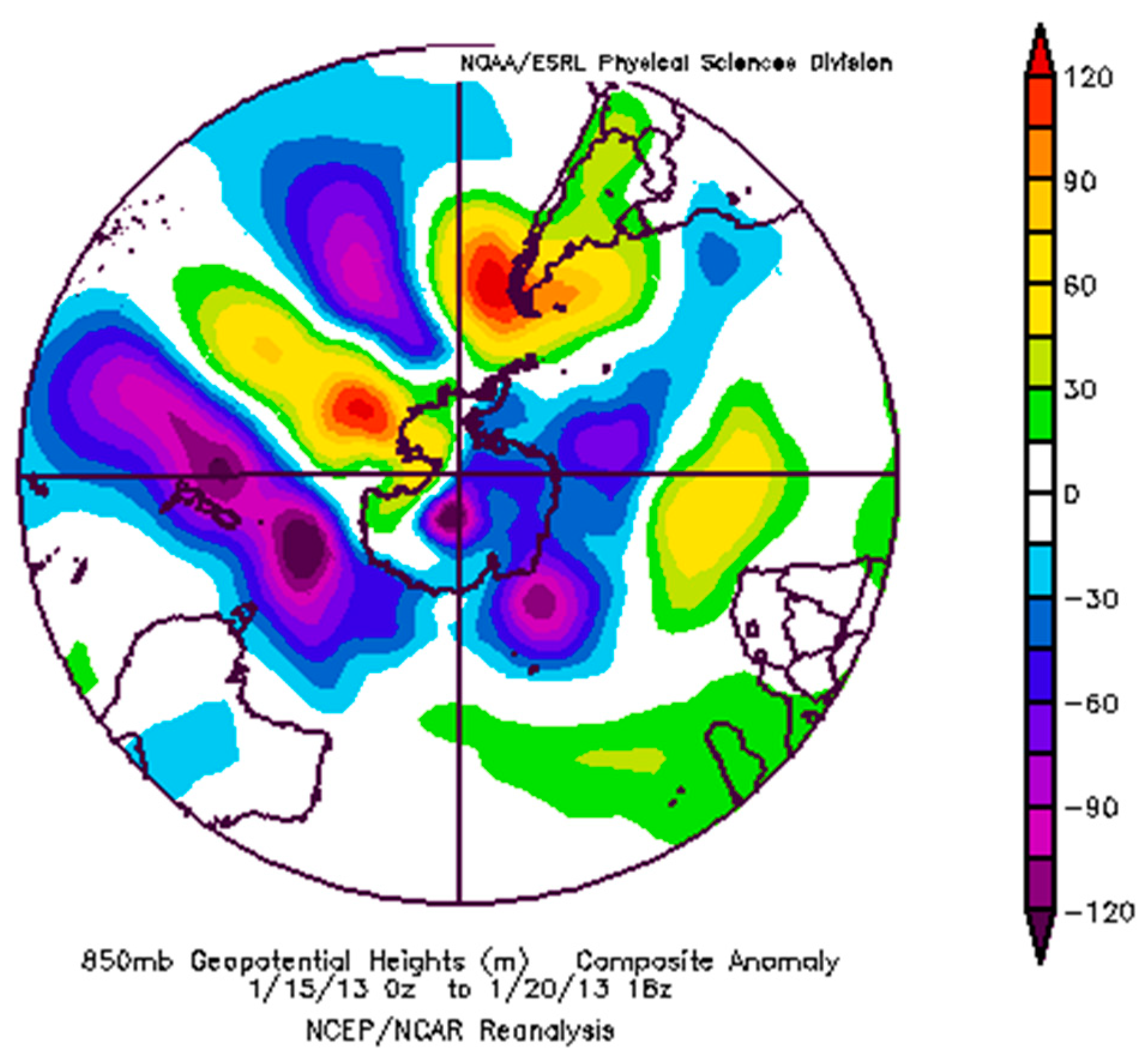
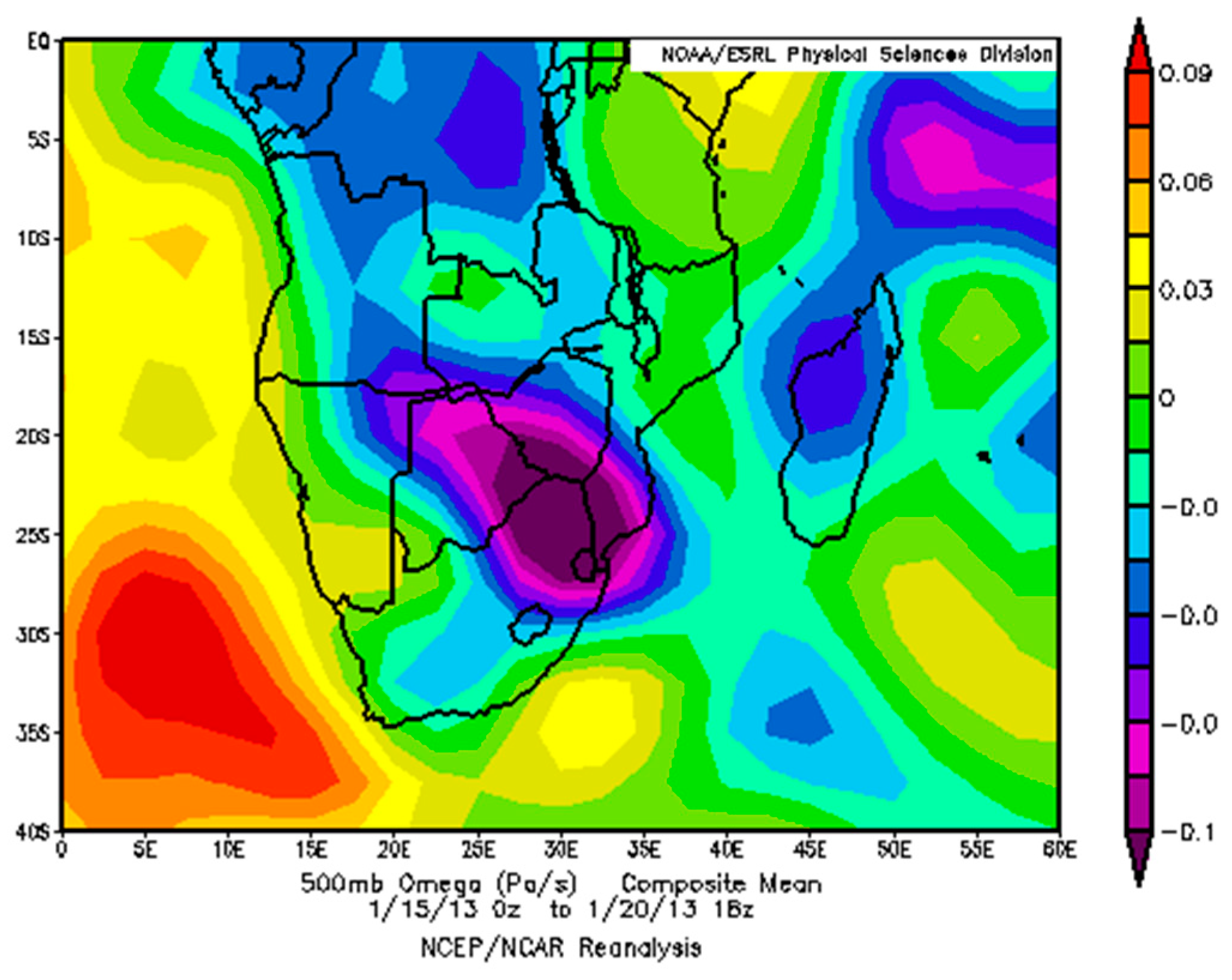
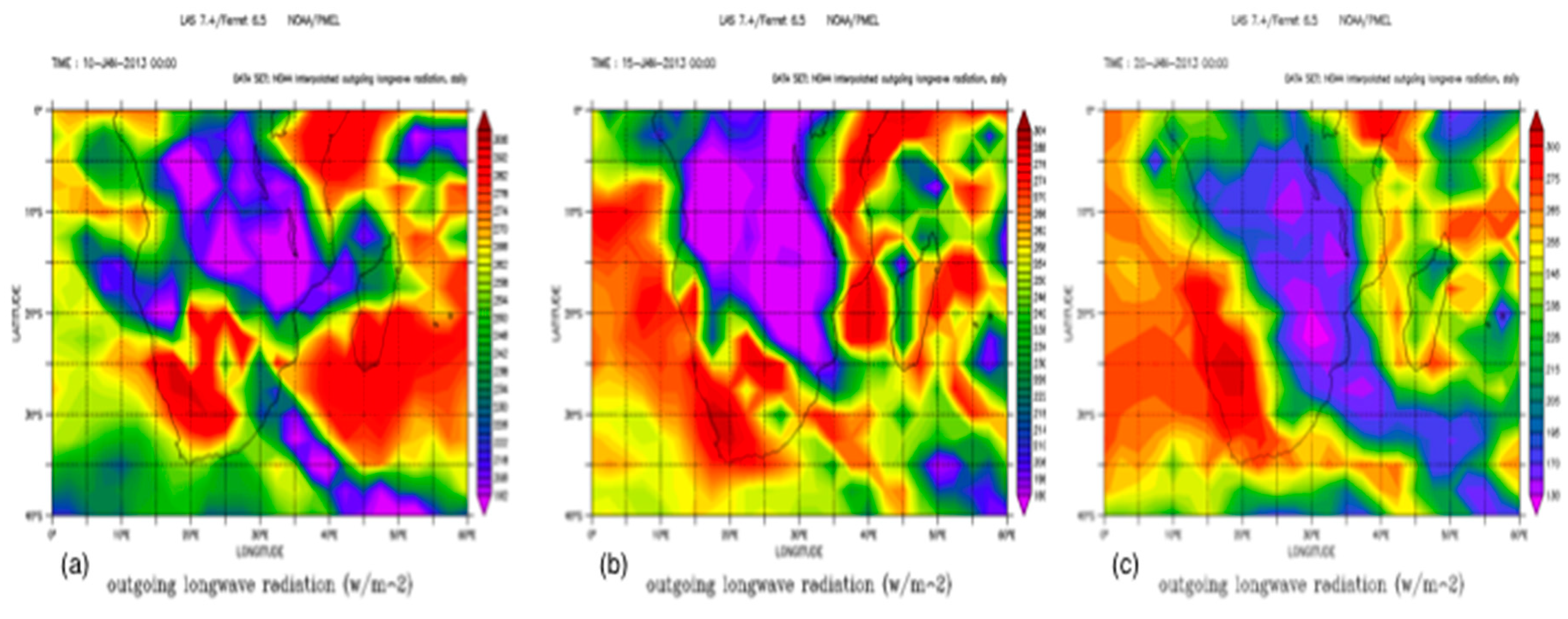
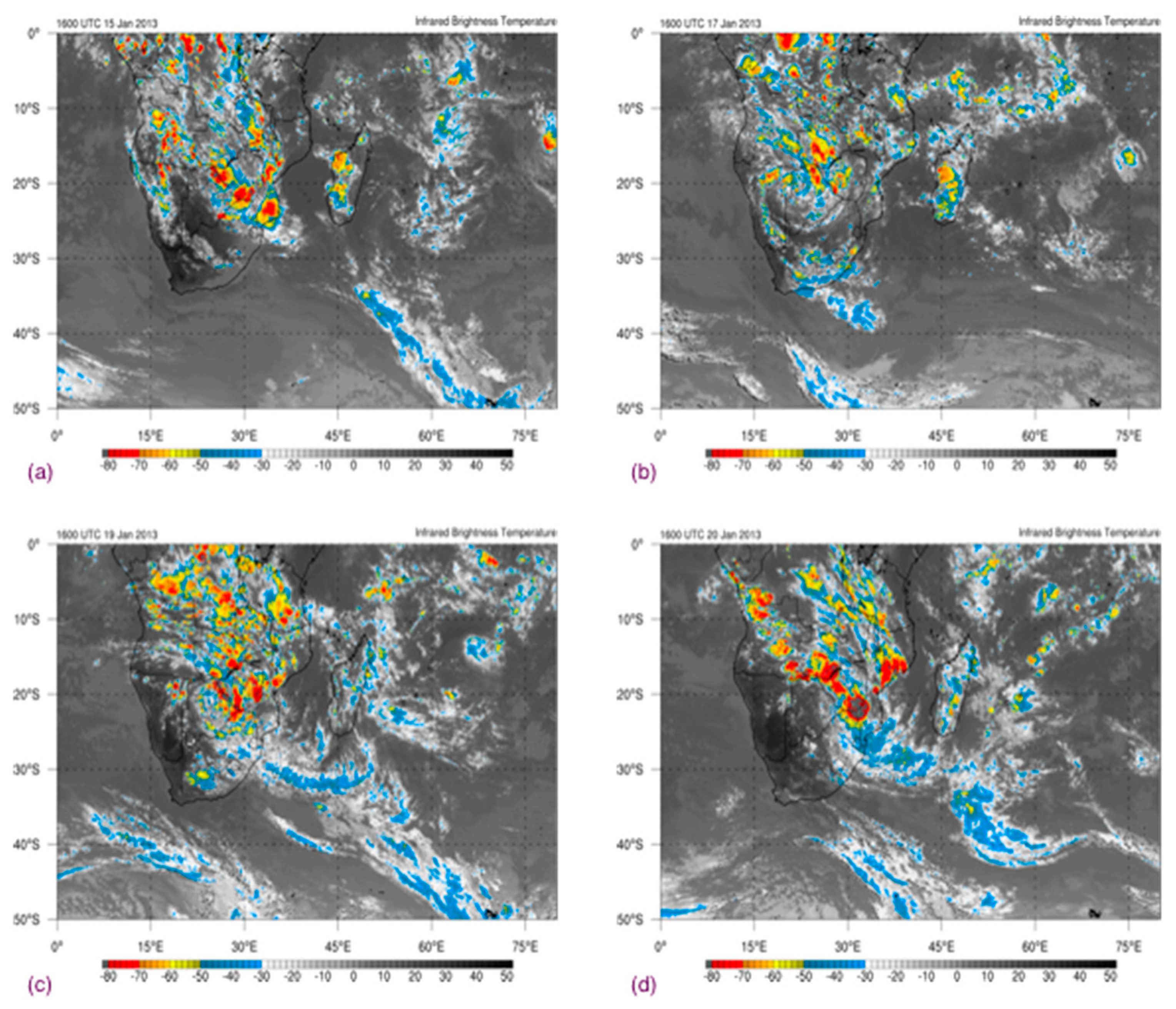
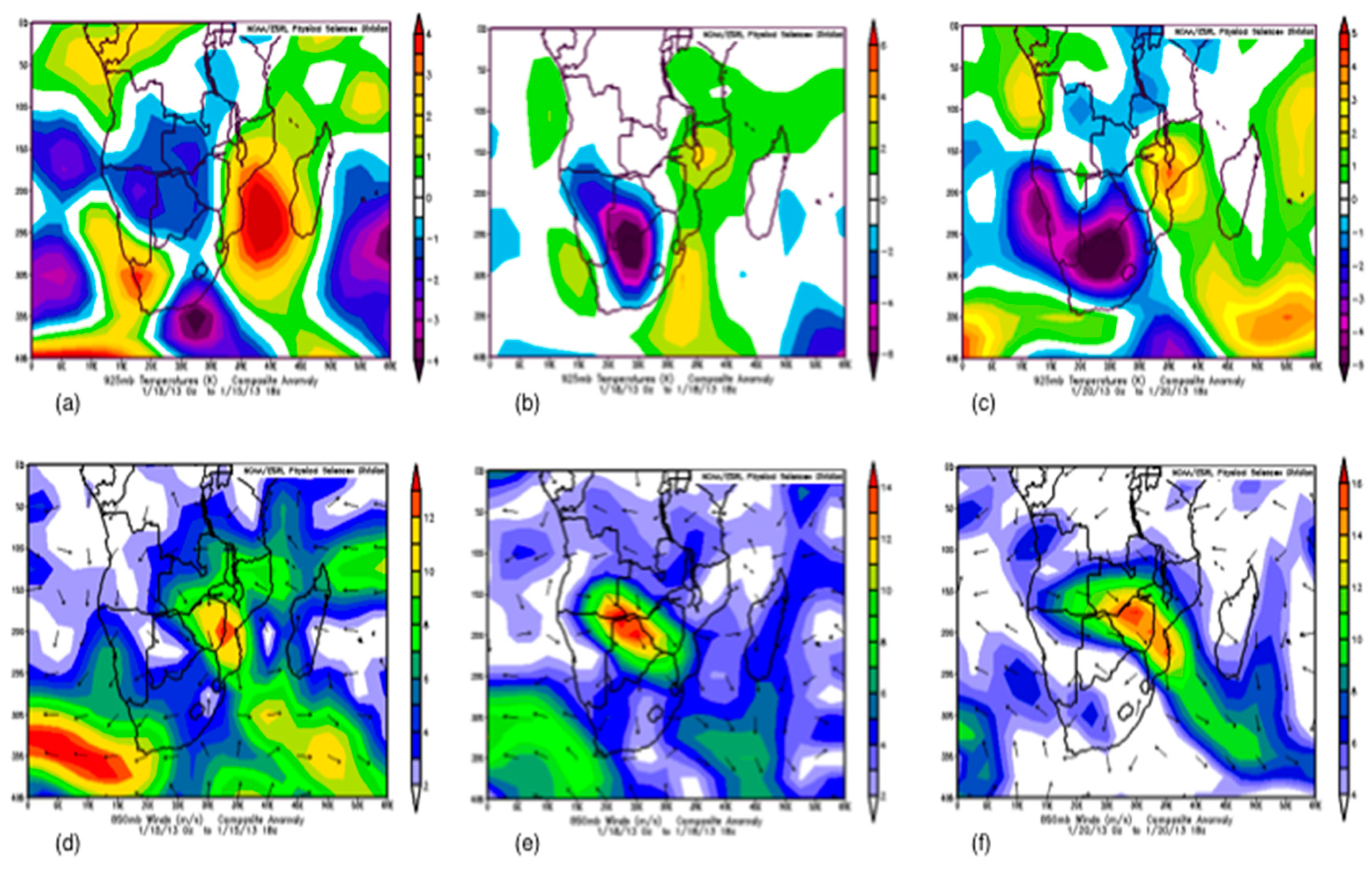
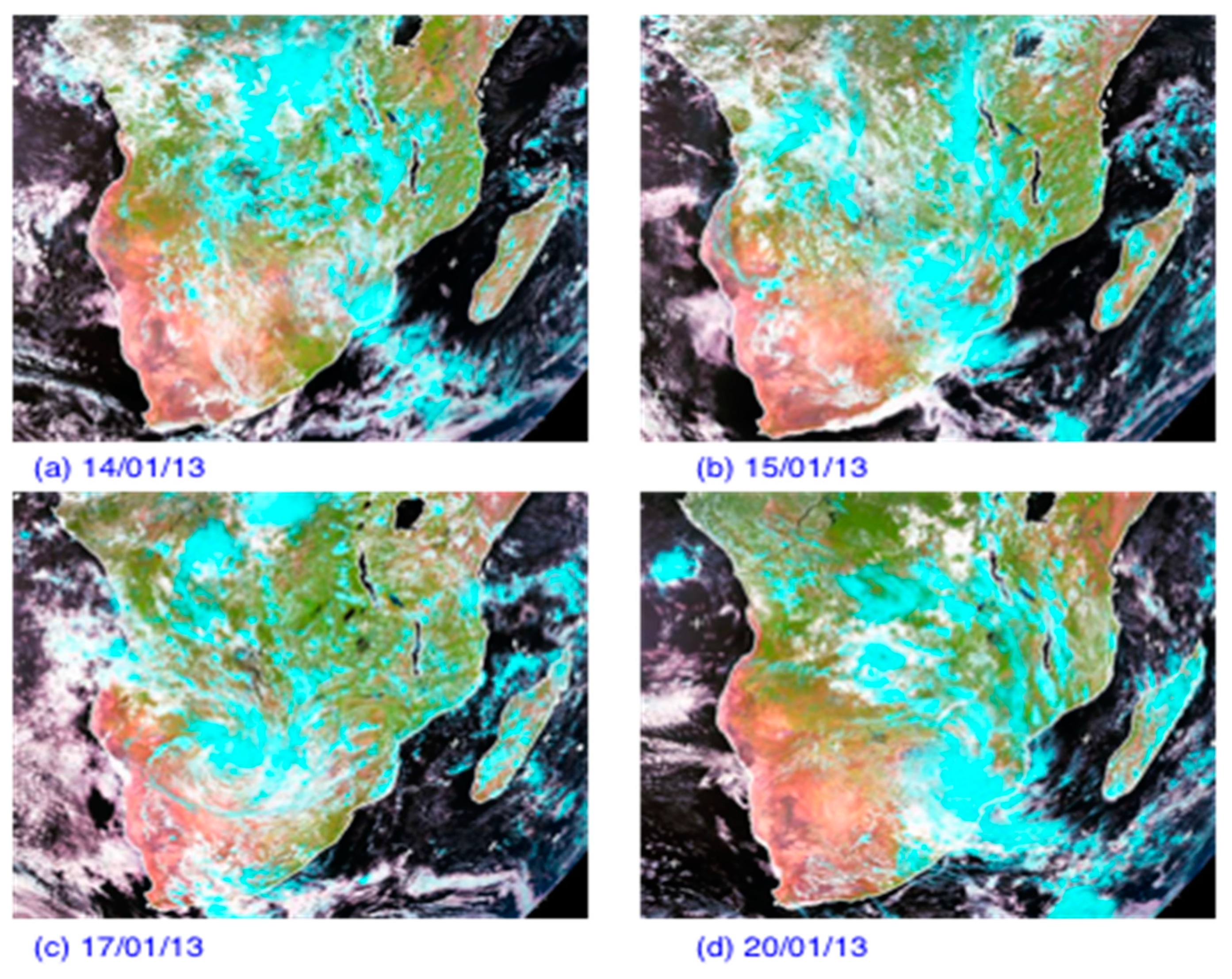
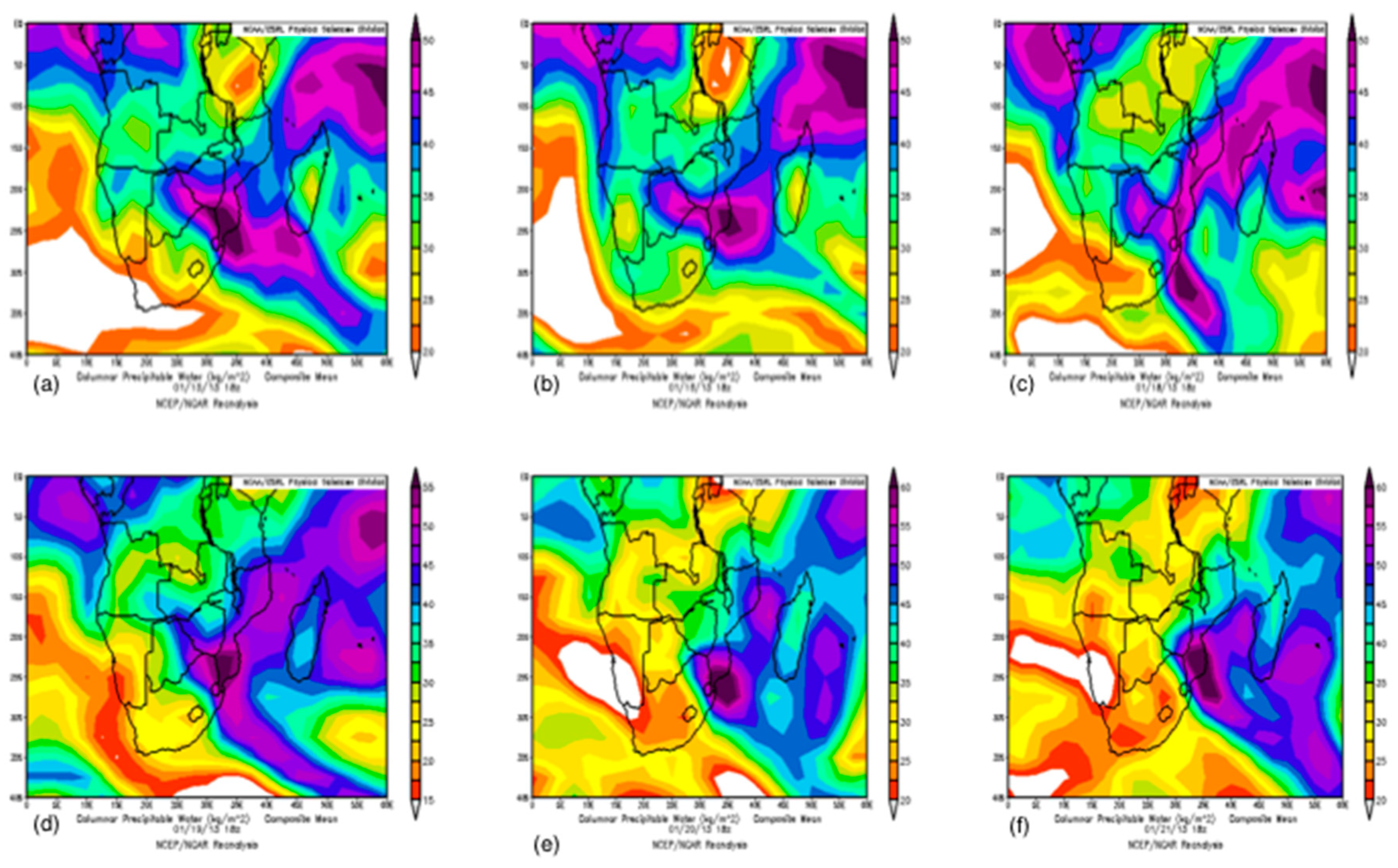
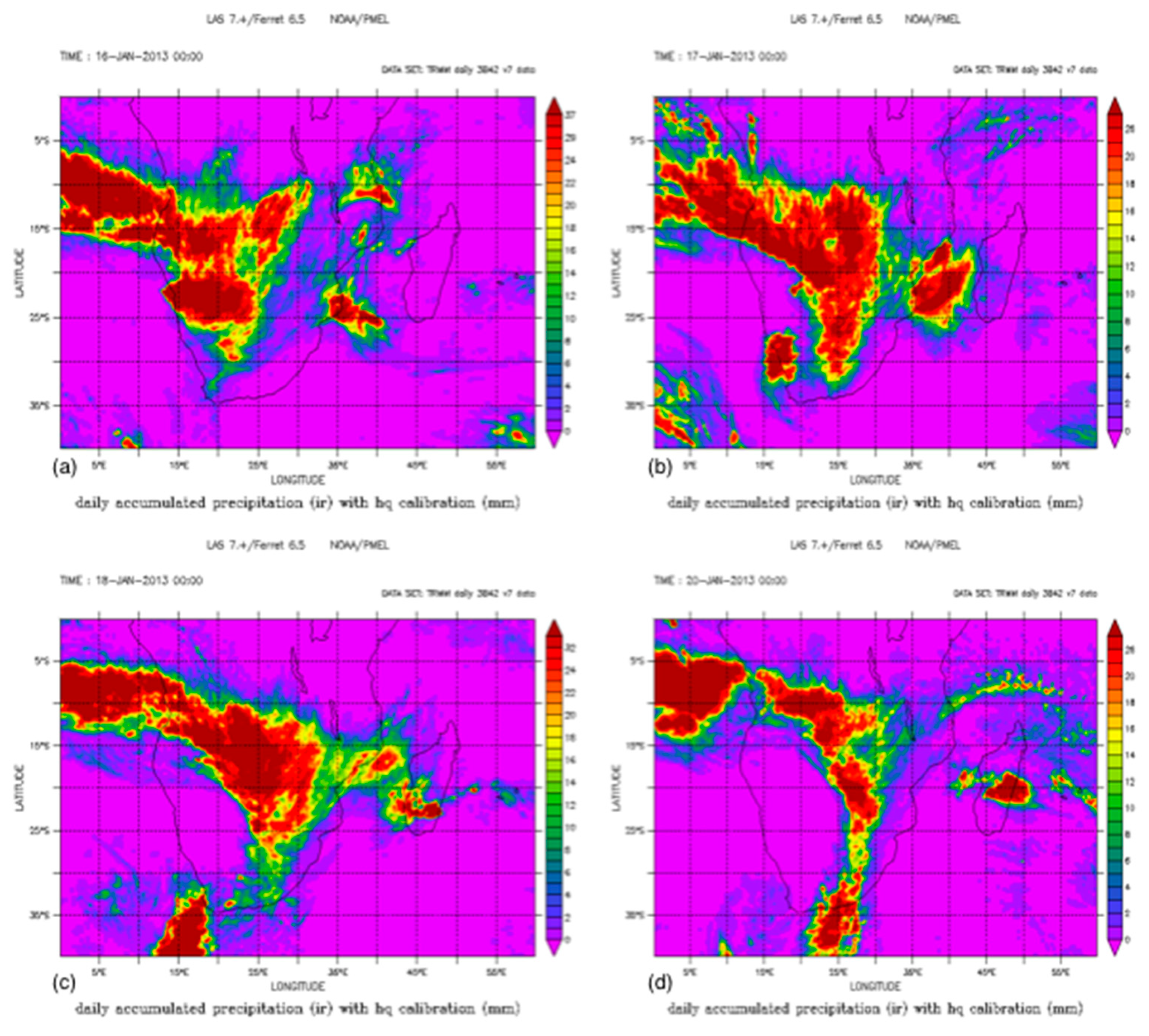
| Country | Rainfall Pattern | Impacts Due to Flooding |
|---|---|---|
| Botswana | Heavy rains caused extensive flooding in the Central Province between 16–23 January | At least 842 families (4210 people) affected. Torrential rains destroyed homes, road, livestock, livelihoods; flooded dams and fields. |
| Malawi | Heavy rains recorded from mid December 2012 to mid January 2013; flooding in several districts, with Magochi District in the southern part being the most affected. | Houses collapsed and roads rendered impassable; livestock and crops washed away. Total of 16,370 people affected; the country faced acute food shortage, exacerbating the situation for the flood-affected communities. |
| Mozambique | Authorities declared an orange alert due to heavy rains on 12 January; another institutional alert declared on 22 January. | At least 113 people killed and over 185,000 people temporarily displaced. |
| Namibia | Heavy rains and rising river levels in the Zambezi River catchment since early January, causing flooding in the Caprivi region. | Community houses, infrastructure and crop fields were flooded. Up to 2500 families (11,000 people) evacuated. |
| Zambia | Heavy rains caused flooding from 17 January to 13 February, with Mumbwa District in the central province being the most affected. | Agricultural fields, infrastructure and property were damaged and destroyed. Drinking water contaminated by floodwaters. About 1800 people affected. |
| Madagascar | Heavy precipitation affected the central and south-western part around 15 February | Eight people killed, and 2146 people displaced or left homeless |
| La Réunion Island | A 1 h rainfall above 100 mm in a short time recorded at Fond du Sac on 13 February | Houses and schools were flooded. |
© 2019 by the authors. Licensee MDPI, Basel, Switzerland. This article is an open access article distributed under the terms and conditions of the Creative Commons Attribution (CC BY) license (http://creativecommons.org/licenses/by/4.0/).
Share and Cite
Wiston, M.; Mphale, K.M. Mesoscale Convective Systems: A Case Scenario of the ‘Heavy Rainfall’ Event of 15–20 January 2013 over Southern Africa. Climate 2019, 7, 73. https://doi.org/10.3390/cli7060073
Wiston M, Mphale KM. Mesoscale Convective Systems: A Case Scenario of the ‘Heavy Rainfall’ Event of 15–20 January 2013 over Southern Africa. Climate. 2019; 7(6):73. https://doi.org/10.3390/cli7060073
Chicago/Turabian StyleWiston, Modise, and Kgakgamatso Marvel Mphale. 2019. "Mesoscale Convective Systems: A Case Scenario of the ‘Heavy Rainfall’ Event of 15–20 January 2013 over Southern Africa" Climate 7, no. 6: 73. https://doi.org/10.3390/cli7060073
APA StyleWiston, M., & Mphale, K. M. (2019). Mesoscale Convective Systems: A Case Scenario of the ‘Heavy Rainfall’ Event of 15–20 January 2013 over Southern Africa. Climate, 7(6), 73. https://doi.org/10.3390/cli7060073





